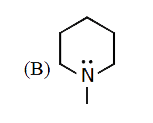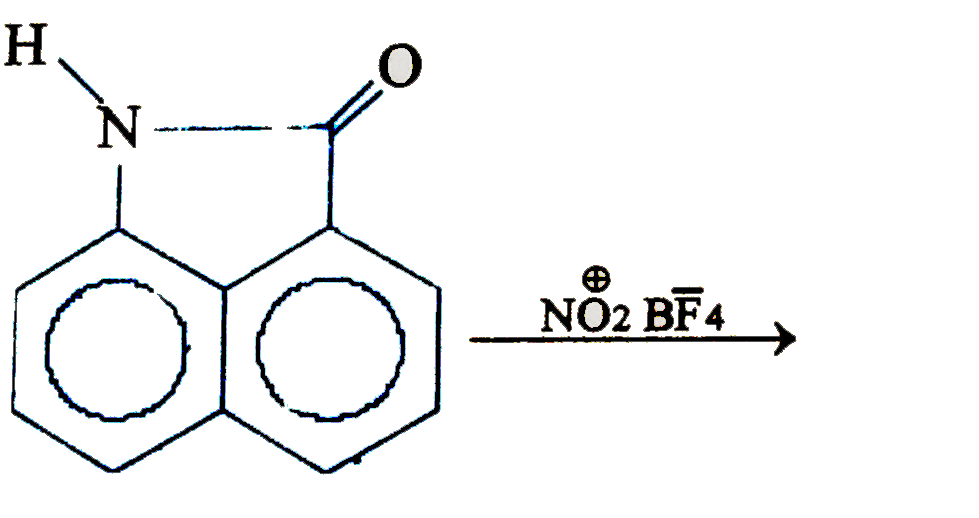Which of the following group activates the benzene ring most towards electrophilic substitution
−CHO
−NR2
−NHCOCH3
−NO2
The correct Answer is:B
To determine which group activates the benzene ring most towards electrophilic substitution, we need to analyze the groups provided: CHO (aldehyde), NR2 (amine), NHCO-CH3 (amide), and NO2 (nitro).
1. Identify the Groups: The groups attached to the benzene ring are:
- CHO (aldehyde)
- NR2 (amine)
- NHCO-CH3 (amide)
- NO2 (nitro)
2. Understand Activation and Deactivation:
- Activating groups increase the electron density of the benzene ring, making it more reactive towards electrophiles.
- Deactivating groups decrease the electron density, making the ring less reactive.
3. Analyze Each Group:
- CHO (Aldehyde): This group is a deactivating group because it pulls electron density away from the benzene ring through resonance and inductive effects.
- NR2 (Amine): This group is an activating group. It donates electron density to the benzene ring through resonance, making the ring more reactive towards electrophiles.
- NHCO-CH3 (Amide): This group is also a deactivating group. Although it has some resonance donation, the carbonyl (C=O) pulls electron density away, making it less activating than an amine.
- NO2 (Nitro): This is a strong deactivating group. It withdraws electron density from the benzene ring through resonance and inductive effects, making the ring less reactive.
4. Rank the Groups: Based on their effects on the benzene ring:
- Most activating: NR2 (Amine)
- Moderately activating: NHCO-CH3 (Amide)
- Deactivating: CHO (Aldehyde) and NO2 (Nitro)
5. Conclusion: The NR2 group activates the benzene ring the most towards electrophilic substitution due to its strong electron-donating resonance effect.
Final Answer:
The NR2 group activates the benzene ring most towards electrophilic substitution.
- CHO (aldehyde)
- NR2 (amine)
- NHCO-CH3 (amide)
- NO2 (nitro)
- Activating groups increase the electron density of the benzene ring, making it more reactive towards electrophiles.
- Deactivating groups decrease the electron density, making the ring less reactive.
- CHO (Aldehyde): This group is a deactivating group because it pulls electron density away from the benzene ring through resonance and inductive effects.
- NR2 (Amine): This group is an activating group. It donates electron density to the benzene ring through resonance, making the ring more reactive towards electrophiles.
- NHCO-CH3 (Amide): This group is also a deactivating group. Although it has some resonance donation, the carbonyl (C=O) pulls electron density away, making it less activating than an amine.
- NO2 (Nitro): This is a strong deactivating group. It withdraws electron density from the benzene ring through resonance and inductive effects, making the ring less reactive.
- Most activating: NR2 (Amine)
- Moderately activating: NHCO-CH3 (Amide)
- Deactivating: CHO (Aldehyde) and NO2 (Nitro)
The NR2 group activates the benzene ring most towards electrophilic substitution.
Topper's Solved these Questions
- BOOK - ERRORLESS CHAPTER - HYDROCARBONEXERCISE - CRITICAL THINKING (Objective questions)24videos
HYDROCARBON
- BOOK - ERRORLESS CHAPTER - HYDROCARBONEXERCISE - JEE SECTION (Only one choice correct answer)93videos
HYDROCARBON
- BOOK - ERRORLESS CHAPTER - HYDROCARBONEXERCISE - ORDINARY THINKING (Objective question) (ALKYNE)120videos
HYDROCARBON
- BOOK - ERRORLESS CHAPTER - HALOGEN CONTAINING COMPOUNDEXERCISE - Critical Thinking (Jee (Advanced) 2018)1videos
HALOGEN CONTAINING COMPOUND
- BOOK - ERRORLESS CHAPTER - IONIC EQUILIBRIUMEXERCISE - JS Jee Section (JEE Advanced (Numeric answer type question))1videos
IONIC EQUILIBRIUM
Similar Questions
Explain the fact that in aryl alkyl ethers (i) the alkoxy group activates the benzene ring towards electrophilic substitution and (ii) it directs the incoming substituents to ortho and para position in benzene ring.
View SolutionExplain the fact that in ary alkyl ethers (i) the alkoxy group activates the benzene ring towards electrophilic substitution and (ii) it direct the incoming substituents to ortho - and para - positions in benzene ring.
View Solution
Knowledge Check
- Question 1 - Select One or More
Which of the following group(s) activate the benzene ring towards electrophilic substitution reaction.
A−ClB C−O−O||C−CH3D−C≡..N
C−O−O||C−CH3D−C≡..N - Question 2 - Select One
Which of the following substituents deactivates the benzene ring towards electrophilic substitution?
A−CHOB−NR2C−NHCOCH3D−NO2 - Question 3 - Select One
Which of the following froups groups deactivates the benzene ring towards electrophilic substitution ?
A−NHRB−OHC−COORD−OR
Explain the fact that in aryl ethers, (i) the alkoxy group activates the benzene ring towards electrophilic substitution and (ii) it directs the incoming substituents to ortho and para positions in benzene ring.
View SolutionWhich of the following substituents deactivates the benzene ring towards electrophilic substitution?
View SolutionThe presence of which one of the following group on benzene nucleus activate it towards electrophilic substitution :
View SolutionIf aromatic ring is substituted by more than one group then electrophilic aromatic substitution reaction take place according to more activating group. The group which donates electrons to aromatic ring knwn as activating group and which withdraw electrons from the ring is called electron withdrawing group. generally all lectron releasing groups activates benzene ring towards electrophilic substitution and electron withdrawing groups deactivates ring towards electrophilic substitutions.
Q. Find out major product of following reaction View Solution
View SolutionIf aromatic ring is substituted by more than one group then electrophilic aromatic substitution reaction take place according to more activating group. The group which donates electrons to aromatic ring knwn as activating group and which withdraw electrons from the ring is called electron withdrawing group. generally all lectron releasing groups activates benzene ring towards electrophilic substitution and electron withdrawing groups deactivates ring towards electrophilic substitutions.
Q. Major product formation takes place at which position when the following is subjected for E⊕ substitution
 View Solution
View Solution

